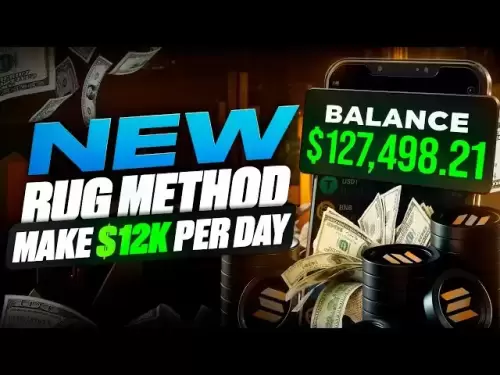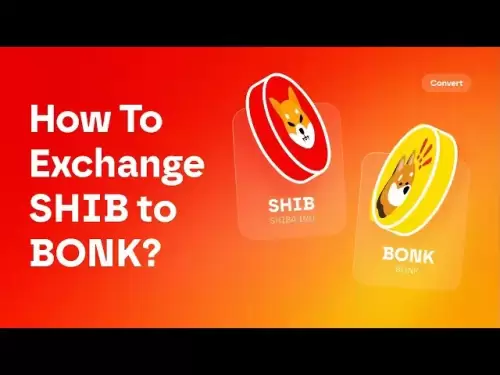-
 Bitcoin
Bitcoin $112400
-1.07% -
 Ethereum
Ethereum $3409
-3.27% -
 XRP
XRP $2.784
-6.60% -
 Tether USDt
Tether USDt $0.9997
-0.03% -
 BNB
BNB $739.3
-2.09% -
 Solana
Solana $158.0
-2.90% -
 USDC
USDC $0.9998
-0.02% -
 TRON
TRON $0.3213
-0.94% -
 Dogecoin
Dogecoin $0.1929
-5.01% -
 Cardano
Cardano $0.6974
-2.82% -
 Hyperliquid
Hyperliquid $36.69
-2.31% -
 Sui
Sui $3.327
-4.80% -
 Stellar
Stellar $0.3672
-5.18% -
 Chainlink
Chainlink $15.65
-3.07% -
 Bitcoin Cash
Bitcoin Cash $525.0
-1.68% -
 Hedera
Hedera $0.2291
-6.00% -
 Avalanche
Avalanche $20.91
-2.96% -
 Ethena USDe
Ethena USDe $1.000
0.00% -
 Toncoin
Toncoin $3.520
-1.12% -
 UNUS SED LEO
UNUS SED LEO $8.968
0.14% -
 Litecoin
Litecoin $105.7
0.26% -
 Shiba Inu
Shiba Inu $0.00001181
-1.79% -
 Polkadot
Polkadot $3.492
-2.08% -
 Uniswap
Uniswap $8.800
-3.10% -
 Dai
Dai $0.9999
-0.01% -
 Monero
Monero $289.9
-3.17% -
 Bitget Token
Bitget Token $4.243
-1.27% -
 Pepe
Pepe $0.00001006
-3.67% -
 Cronos
Cronos $0.1248
-5.68% -
 Aave
Aave $249.7
-2.50%
How to use market orders and limit orders in OKX contracts?
OKX offers market orders for immediate execution (with potential slippage) and limit orders for price certainty (but no guaranteed execution). Understanding these order types, leverage, and position sizing is crucial for successful cryptocurrency trading on OKX.
Mar 26, 2025 at 06:00 am

Key Points:
- Understanding the difference between market orders and limit orders is crucial for successful cryptocurrency trading.
- Market orders guarantee execution but may result in slippage, while limit orders offer price certainty but don't guarantee execution.
- OKX provides a user-friendly interface for placing both market and limit orders on their contracts platform.
- Careful consideration of order types and risk management is essential for maximizing profits and minimizing losses.
- Understanding leverage and position sizing within the context of order types is critical.
How to Use Market Orders and Limit Orders in OKX Contracts
Navigating the world of cryptocurrency contracts trading on platforms like OKX requires a solid understanding of order types. Two fundamental order types are market orders and limit orders. Each serves a distinct purpose and carries different levels of risk. Choosing the right order type depends heavily on your trading strategy and risk tolerance.
Market Orders on OKX Contracts:
A market order is an instruction to buy or sell a contract at the best available price immediately. This means the order is executed instantly at the current market price. The advantage is guaranteed execution; your order will fill, regardless of price fluctuations. However, this comes at the cost of potential slippage. Slippage is the difference between the expected price and the actual execution price. This is particularly relevant during periods of high volatility or low liquidity.
To place a market order on OKX:
- Navigate to the OKX contracts trading interface for your chosen contract.
- Specify the contract you want to trade.
- Enter the quantity of contracts you wish to buy or sell.
- Select "Market" as the order type.
- Click "Buy/Sell" to execute the order.
Limit Orders on OKX Contracts:
Unlike market orders, limit orders allow you to specify the exact price at which you want to buy or sell a contract. This order will only be executed if the market price reaches your specified limit price. The advantage is price certainty; you control the price at which you enter or exit a position. The disadvantage is that there's no guarantee your order will be filled. If the market price doesn't reach your limit price, your order will remain unfilled.
Placing a limit order on OKX involves these steps:
- Navigate to the OKX contracts trading interface.
- Select the contract and enter the desired quantity.
- Choose "Limit" as the order type.
- Input your desired limit price.
- Click "Buy/Sell" to place the order. The order will remain active until filled or canceled.
Understanding Leverage and Position Sizing
Leverage significantly impacts the risk associated with both market and limit orders. Leverage magnifies both profits and losses. With higher leverage, smaller price movements can lead to substantial gains or losses. Therefore, careful position sizing is crucial. Position sizing refers to determining the appropriate quantity of contracts to trade based on your risk tolerance and account balance.
Always consider your risk tolerance when using leverage. Never risk more capital than you can afford to lose.
Using Stop-Limit Orders (A Combination)
OKX also supports stop-limit orders, which combine elements of both limit and stop orders. A stop-limit order is a conditional order that becomes a limit order once a specific price (the stop price) is reached. This helps manage risk by limiting potential losses or securing profits.
- Set your stop price, the price at which the order becomes a limit order.
- Set your limit price, the price at which you want to buy or sell once the stop price is triggered.
If the market price reaches the stop price, the stop-limit order converts into a limit order at the specified limit price.
Managing Your Orders on OKX
OKX provides tools to manage your open orders. You can view your open orders, modify them (if allowed), or cancel them at any time before execution. This allows for flexibility in adapting to changing market conditions.
Risk Management Considerations
Regardless of the order type used, robust risk management is paramount. This involves setting stop-loss orders to limit potential losses and taking profits when appropriate. Never invest more than you can afford to lose. Diversification across different contracts can also help mitigate risk.
Frequently Asked Questions:
Q: What is the difference between a market order and a limit order in OKX contracts?
A: A market order executes immediately at the best available price, while a limit order only executes if the market price reaches your specified limit price. Market orders guarantee execution but may result in slippage, while limit orders offer price certainty but don't guarantee execution.
Q: Can I cancel a limit order on OKX before it's filled?
A: Yes, you can cancel a limit order on OKX before it's filled. OKX provides tools to manage and cancel your open orders.
Q: What is slippage, and how does it affect market orders?
A: Slippage is the difference between the expected price and the actual execution price of a trade. It's more likely to occur with market orders, especially during periods of high volatility or low liquidity.
Q: How does leverage affect my risk when using market and limit orders?
A: Leverage magnifies both profits and losses. Higher leverage increases the risk of substantial losses, even with small price movements. Careful position sizing is crucial when using leverage.
Q: What are stop-limit orders, and how do they work in OKX contracts?
A: A stop-limit order combines a stop order and a limit order. It becomes a limit order once the market price reaches the specified stop price. This allows you to set a price at which you want to buy or sell after a certain price movement.
Disclaimer:info@kdj.com
The information provided is not trading advice. kdj.com does not assume any responsibility for any investments made based on the information provided in this article. Cryptocurrencies are highly volatile and it is highly recommended that you invest with caution after thorough research!
If you believe that the content used on this website infringes your copyright, please contact us immediately (info@kdj.com) and we will delete it promptly.
- BlockDAG, SEI, Ethena: Top Crypto Performers Under the Microscope
- 2025-08-03 10:50:16
- Bitcoin Blasts Past $119K: How Institutional Adoption and Macro Shifts Fuel the Fire
- 2025-08-03 10:55:16
- Crypto, Grok, and August: Decoding the Latest Trends and Insights
- 2025-08-03 11:10:16
- Crypto, Phishing, and Your Wallet: A New Yorker's Guide to Staying Safe
- 2025-08-03 10:30:16
- Troller Cat Meme Coin Presale Soars: A New King in the Crypto Jungle?
- 2025-08-03 10:30:16
- Grayscale, Altcoin Trust, and Mid-Cap Mania: What's the Deal?
- 2025-08-03 08:50:16
Related knowledge

Why is my Bitstamp futures position being liquidated?
Jul 23,2025 at 11:08am
Understanding Futures Liquidation on BitstampFutures trading on Bitstamp involves borrowing funds to open leveraged positions, which amplifies both po...

How to report Bitstamp futures for taxes?
Jul 30,2025 at 08:35am
Understanding Bitstamp Futures and Taxable EventsWhen trading Bitstamp futures, it’s essential to recognize that these financial instruments are treat...

Does Bitstamp offer inverse contracts?
Jul 23,2025 at 01:28pm
Understanding Inverse Contracts in Cryptocurrency TradingIn the realm of cryptocurrency derivatives, inverse contracts are a specific type of futures ...

What is the difference between futures and perpetuals on Bitstamp?
Jul 27,2025 at 05:08am
Understanding Futures Contracts on BitstampFutures contracts on Bitstamp are financial derivatives that allow traders to speculate on the future price...

How to find your Bitstamp futures trade history?
Jul 23,2025 at 08:07am
Understanding Bitstamp and Futures Trading AvailabilityAs of the current state of Bitstamp’s service offerings, it is critical to clarify that Bitstam...

Can I use a trailing stop on Bitstamp futures?
Jul 23,2025 at 01:42pm
Understanding Trailing Stops in Cryptocurrency TradingA trailing stop is a dynamic type of stop-loss order that adjusts automatically as the price of ...

Why is my Bitstamp futures position being liquidated?
Jul 23,2025 at 11:08am
Understanding Futures Liquidation on BitstampFutures trading on Bitstamp involves borrowing funds to open leveraged positions, which amplifies both po...

How to report Bitstamp futures for taxes?
Jul 30,2025 at 08:35am
Understanding Bitstamp Futures and Taxable EventsWhen trading Bitstamp futures, it’s essential to recognize that these financial instruments are treat...

Does Bitstamp offer inverse contracts?
Jul 23,2025 at 01:28pm
Understanding Inverse Contracts in Cryptocurrency TradingIn the realm of cryptocurrency derivatives, inverse contracts are a specific type of futures ...

What is the difference between futures and perpetuals on Bitstamp?
Jul 27,2025 at 05:08am
Understanding Futures Contracts on BitstampFutures contracts on Bitstamp are financial derivatives that allow traders to speculate on the future price...

How to find your Bitstamp futures trade history?
Jul 23,2025 at 08:07am
Understanding Bitstamp and Futures Trading AvailabilityAs of the current state of Bitstamp’s service offerings, it is critical to clarify that Bitstam...

Can I use a trailing stop on Bitstamp futures?
Jul 23,2025 at 01:42pm
Understanding Trailing Stops in Cryptocurrency TradingA trailing stop is a dynamic type of stop-loss order that adjusts automatically as the price of ...
See all articles

























































































